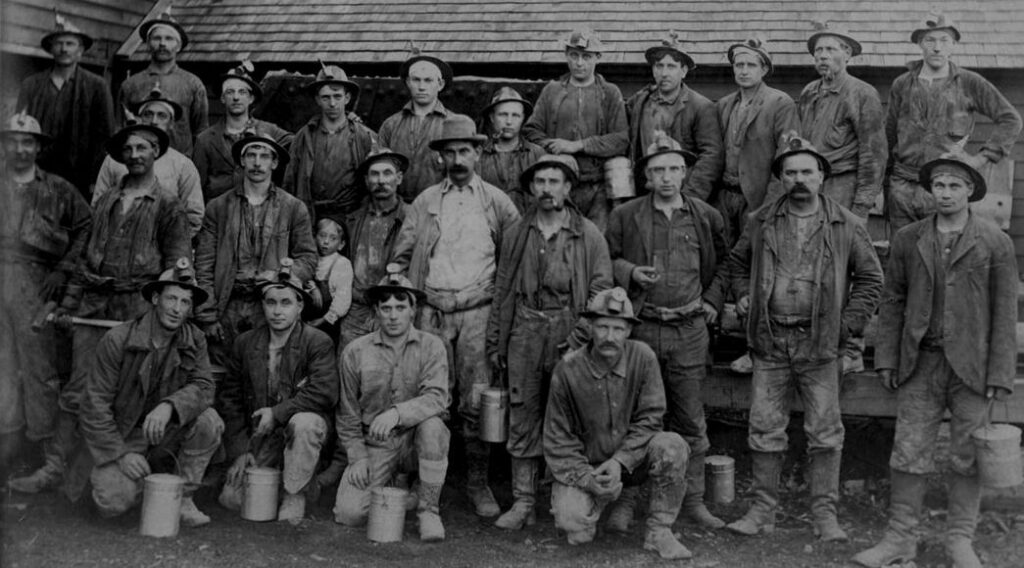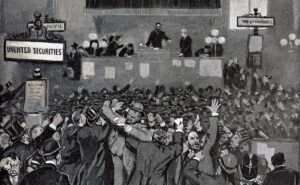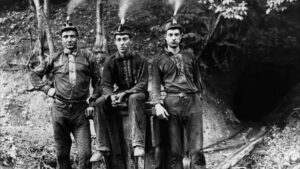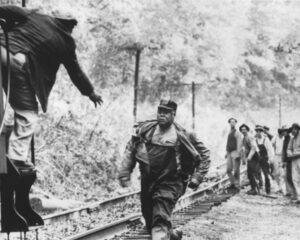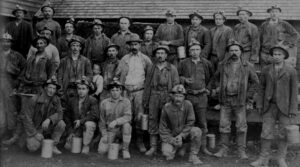
Before we get into the story of the Matewan Massacre, we need to do some back history and how things were already heated between the coal miners and the coal companies long before that point in history. What happened at the Paint-Cabin Creek strike is often regarded as one of the worst and first serious confrontations between coal miners and the coal companies at the beginning of the 1900s. Considered to be one of the first major conflicts of the Coal Wars that was to hit the region over the next several years. The Confrontation lasted between April 18, 1912, through July 1913. Several other labor-related conflicts would happen over the following years ending with the Battle of Matewan and the Battle of Blair Mountain.
Panic of 1893
From the years 1893 through 1897, there was a severe economic downturn that caused economic depression in the United States. This also affected the Presidency of William McKinley and caused a huge political upheaval. This upheaval caused the re-election of U.S. President Grover Cleveland.
There have been several causes as to why this happened. Some of which is that the United States economy of that time was dependent on high international commodity prices. Also including investments and were made to the Baring Brothers Bank in Argentina that had failed. The wheat crop failure of 1890. A failed coup de tat in Buenos Aires. A run on gold in the U.S. Treasury (the US was on the gold standard at that time). People began to hoard their bullion coins because they were afraid that they would lose everything. Also, Philadelphia ad Reading Railroad had over-extended themselves and was now having receivers appointed for them. Also, the policies of President Benjamin Harrison have been named as a contributing factor to this depression. President Cleveland had Congress repeal the Sherman Silver Purchase Act.
Because the coal companies of that time were also feeling the pressure from the Depression, they cut wages to their workers to keep solvent.
United Mine Workers (UMW)
The United Mine Workers was founded in Columbus, Ohio on January 22, 1890, by the merger of the Knights of Labor Trade Assembly No. 135 and the National Progressive Miners Union. The reason behind the merger was that the two competing former unions were creating more problems for the miners than solving them. The idea behind the merger was to unite and organize mine workers and others in adjacent occupations into a more effective negotiating unit. With the Coal operators reducing wages, and the mines being a dangerous place to work, with the operators denying a lot of the miner’s rights, the UMW started to gain ground on membership.
The United Mine Workers Union came together to make a working eleven-point Constitution to help its workers.
The UMW Constitution Listed Eleven Points as the Union’s Goals:
- Payment of a salary commensurate with the dangerous work conditions. This was one of the most important points of the constitution.
- Payment to be made fairly in legal tender, not with company scrip.
- Provide safe working conditions, with operators to use the latest technologies in order to preserve the lives and health of workers.
- Provide better ventilation systems to decrease black lung disease, and better drainage systems.
- Enforce safety laws and make it illegal for mines to have inadequate roof supports, or contaminated air and water in the mines.
- Limit regular hours to an eight-hour work day.
- End child labor, and strictly enforce the child labor law.
- Have accurate scales to weigh the coal products, so workers could be paid fairly. Many operators had altered scales that showed a lighter weight of coal than actually produced, resulting in underpayment to workers. Miners were paid per pound of coal that they produced.
- Payment should be made in legal tender.
- Establish unbiased public police forces in the mine areas that were not controlled by the operators. Many operators hired private police, who were used to harass the mine workers and impose company power. In company towns, the operators owned all the houses and controlled the police force; they could arbitrarily evict workers and arrest them unjustly.
- The workers reserved the right to strike, but would work with operators to reach reasonable conclusions to negotiations.
The Coal Camps and the Growth of the United Mine Workers Union
United Mine Workers union (UMW) was a response to the wage reductions from the Panic of 1893. By 1902, the union membership of the entire state of West Virginia had grown to 5,000 miners. However, these numbers were still very low especially in the Southern Appalachian part of the state.
Before the Strike of 1912, there were 96 coal mines in operation in the Kanawha County, West Virginia area. There were approximately 7,500 coal miners employed. All 41 mines that were located on Paint Creek and the surrounding area were unionized. There were 55 mines on Cabin Creek that had no union. The miners of Paint Creek received 2.5 cents less on each ton of coal than other miners of that area.
The First Demands
When the Union contract was up for negotiation, the Paint Creek Union tried to settle a new contract with the operators. In the negotiations was a raise for the miners to have the same compensation rate as the surrounding area and for automatic union dues. This increase would cost the operators approximately 15 cents per miner per day. The operators refused this increase and no new contract was made. The operators also withdrew their recognition of the UMW.
The Strike
When the negotiations failed, the union called for a strike on April 18, 1912.
- That the operators accept and recognize the union.
- That the miners’ right to free speech and peaceable assembly be restored.
- That black-listing discharged workers be stopped.
- That compulsory trading at company stores be ended.
- That cribbing be discontinued and that 2,000 pounds of mined coal constitute a ton.
- That scales be installed at mines to weigh the tonnage of the miners.
- That miners be allowed to employ their own check-weigh men to check against the weights found by company check-weigh men, as provided by law.
- That the two check-weigh men determine all docking penalties.
Holly Grove Tent City Established
After debate, all 7,500 miners from non-union mines Cabin Creek, Kanawha (kə-NAW or kə-NAW-ə), and Fayette Counties also joined in with the striking miners of Paint Creek and declared their own strike as well. The union set up tent camps for the miners and their families as they were evicted from the company’s own homes without warning from their houses.
During this time, UMW Vice-President Frank Hayes and well-known labor activist Mary “Mother” Jones would visit the area to give encouragement and support to the miners and their families. The National United Mine Workers Union pledged its full support giving full financing and any aid that was needed to the striking miners. Because of this influence, the first month of the strike was peaceful.
We will leave this here with everything being peaceful in the camps. In the next post, we will discuss the involvement of the Baldwin–Felts Detective Agency and the first volleys of the Strike.
Source Information
United Mine Workers
https://en.wikipedia.org/wiki/United_Mine_Workers
Paint Creek–Cabin Creek strike of 1912
https://en.wikipedia.org/wiki/Paint_Creek%E2%80%93Cabin_Creek_strike_of_1912
West Virginia coal wars
https://en.wikipedia.org/wiki/West_Virginia_coal_wars
Paint Creek–Cabin Creek strike of 1912
https://infogalactic.com/info/Paint_Creek%E2%80%93Cabin_Creek_strike_of_1912
Mother Jones
https://en.wikipedia.org/wiki/Mother_Jones
Paint Creek and Cabin Creek Strikes
https://www.nps.gov/articles/000/paint-creek-and-cabin-creek-strikes.htm
Paint Creek-Cabin Creek Strike of 1912
https://paintschoices.blogspot.com/2017/02/paint-creek-cabin-creek-strike-of-1912_24.html
The Panic of 1893
https://en.wikipedia.org/wiki/Panic_of_1893
The Panic of 1893
https://florencekelley.northwestern.edu/historical/panic/
Copyright and Other Information
Copyrighted through a Creative Commons License.
This work is licensed under a Creative Commons
Social Media Pages
Facebook
https://facebook.com/kytnliving
Twitter
https://twitter.com/KYTNLiving
YouTube
https://youtube.com/kytnliving
When we forget our past and who we are as a people, then we become who “they” say we are. ~~ David Sergent
I have attended the University of Kentucky. I have an Associates Degree from Hazard Community College and Technical School. I have also attended the University of Pikeville. I have taken several classes in Journalism as well as in the Appalachian History, Literature, and Sociology during my time at those schools.
I was born in Florida and grew up in Burdine, Kentucky. I have been married to David W. Sergent since May 4, 2013. I have two children and four grandchildren from a previous marriage. I currently live in Tennessee but my hope is to one day come back home to live in the beautiful mountains once more.


